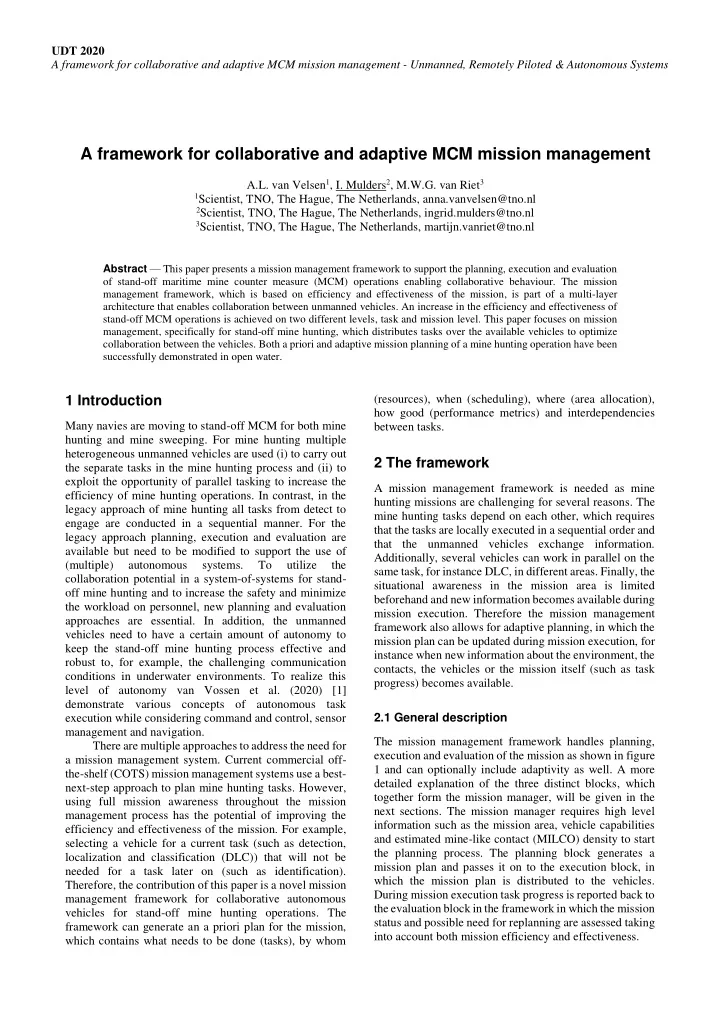

UDT 2020 A framework for collaborative and adaptive MCM mission management - Unmanned, Remotely Piloted & Autonomous Systems A framework for collaborative and adaptive MCM mission management A.L. van Velsen 1 , I. Mulders 2 , M.W.G. van Riet 3 1 Scientist, TNO, The Hague, The Netherlands, anna.vanvelsen@tno.nl 2 Scientist, TNO, The Hague, The Netherlands, ingrid.mulders@tno.nl 3 Scientist, TNO, The Hague, The Netherlands, martijn.vanriet@tno.nl Abstract — This paper presents a mission management framework to support the planning, execution and evaluation of stand-off maritime mine counter measure (MCM) operations enabling collaborative behaviour. The mission management framework, which is based on efficiency and effectiveness of the mission, is part of a multi-layer architecture that enables collaboration between unmanned vehicles. An increase in the efficiency and effectiveness of stand-off MCM operations is achieved on two different levels, task and mission level. This paper focuses on mission management, specifically for stand-off mine hunting, which distributes tasks over the available vehicles to optimize collaboration between the vehicles. Both a priori and adaptive mission planning of a mine hunting operation have been successfully demonstrated in open water. 1 Introduction (resources), when (scheduling), where (area allocation), how good (performance metrics) and interdependencies Many navies are moving to stand-off MCM for both mine between tasks. hunting and mine sweeping. For mine hunting multiple heterogeneous unmanned vehicles are used (i) to carry out 2 The framework the separate tasks in the mine hunting process and (ii) to exploit the opportunity of parallel tasking to increase the A mission management framework is needed as mine efficiency of mine hunting operations. In contrast, in the hunting missions are challenging for several reasons. The legacy approach of mine hunting all tasks from detect to mine hunting tasks depend on each other, which requires engage are conducted in a sequential manner. For the that the tasks are locally executed in a sequential order and legacy approach planning, execution and evaluation are that the unmanned vehicles exchange information. available but need to be modified to support the use of Additionally, several vehicles can work in parallel on the (multiple) autonomous systems. To utilize the same task, for instance DLC, in different areas. Finally, the collaboration potential in a system-of-systems for stand- situational awareness in the mission area is limited off mine hunting and to increase the safety and minimize beforehand and new information becomes available during the workload on personnel, new planning and evaluation mission execution. Therefore the mission management approaches are essential. In addition, the unmanned framework also allows for adaptive planning, in which the vehicles need to have a certain amount of autonomy to mission plan can be updated during mission execution, for keep the stand-off mine hunting process effective and instance when new information about the environment, the robust to, for example, the challenging communication contacts, the vehicles or the mission itself (such as task conditions in underwater environments. To realize this progress) becomes available. level of autonomy van Vossen et al. (2020) [1] demonstrate various concepts of autonomous task 2.1 General description execution while considering command and control, sensor management and navigation. The mission management framework handles planning, There are multiple approaches to address the need for execution and evaluation of the mission as shown in figure a mission management system. Current commercial off- 1 and can optionally include adaptivity as well. A more the-shelf (COTS) mission management systems use a best- detailed explanation of the three distinct blocks, which next-step approach to plan mine hunting tasks. However, together form the mission manager, will be given in the using full mission awareness throughout the mission next sections. The mission manager requires high level management process has the potential of improving the information such as the mission area, vehicle capabilities efficiency and effectiveness of the mission. For example, and estimated mine-like contact (MILCO) density to start selecting a vehicle for a current task (such as detection, the planning process. The planning block generates a localization and classification (DLC)) that will not be mission plan and passes it on to the execution block, in needed for a task later on (such as identification). which the mission plan is distributed to the vehicles. Therefore, the contribution of this paper is a novel mission During mission execution task progress is reported back to management framework for collaborative autonomous the evaluation block in the framework in which the mission vehicles for stand-off mine hunting operations. The status and possible need for replanning are assessed taking framework can generate an a priori plan for the mission, into account both mission efficiency and effectiveness. which contains what needs to be done (tasks), by whom
Recommend
More recommend